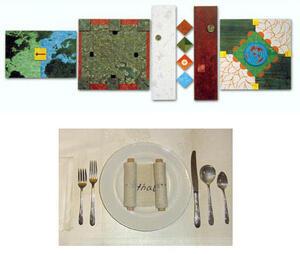Sustenance: Nurturing Bodies and Souls
Nourished by the support of parents and grandparents, the guidance of professional mentors, and the heritage of Jewish values, these women are continuing to nourish and nurture new generations. Jewish women's relationship to food is also a central theme in the narratives. Symbolizing economic sufficiency, family unity, and generational continuity, food figures prominently in stories of family recipes passed from one generation to the next, and especially of lavish weekly Shabbat dinners and Passover seders. Sustenance, defined in our stories, is about nurturing souls as well as bodies.
My theme for this work was sustenance. The oral histories I read were linked in many ways with nourishment. I read these oral histories in the context of time, space, and place, and with a broader question in my mind: What nourished these women and how did they nourish others? Included were Ruth Surosky Levy, whose father owned Surosky's Butcher Shop; Min Shavitz, whose husband, Leon, was one of the founders of Nate's and Leon's delicatessen and later the Pimlico Hotel; Rosalie Silber Abrams, whose family founded Silber's Bakery; Bess Fishman, whose father was a grocer; and Elsie Legum, whose father owned a confectionary store. I saw the 1950s as a point of time when all the women whose oral histories I read were living in the city or suburbs of Baltimore. Some of their children would leave to move to other parts of the USA and abroad. Yet, looking back, the oral histories revealed how these women and their families came to live in Baltimore. The foods and traditions brought to Baltimore (from parents, grandparents, great-grandparents) were from regions of shifting borders—today's Germany, Russia, Ukraine, Lithuania, Poland, Czech Republic and Hungary.
The painting's five parts are: Migration: Over the Ocean; Migration in Baltimore; Meat (Bridges Parve); Milk; and From Baltimore: New Migrations. The images hover between the real and abstract, the larger world and the microscopic world, what is literal and what is metaphorical. Decisions had to be made by these women on what to keep, what to reject, and what to take from outside the Jewish community. The dining table was a place where families came together. Even busy families came together for holidays and many for Sabbath. The table was a site for communication, meals, meetings, homework and more. Physical food alone was not enough to nourish. The "food" on the plates around this table is in the form of woven fabric scrolls, mirroring the Torah, which gives a context to these individual books of life. Inside each scroll are the words: My Story and the Stories that Surround Me: Infinite Intersections. What struck me was how each woman was nourished by her family of origin and through friendships, education and work. They nourish those who were close to them as well as others in synagogues and Jewish institutions, political, service and cultural organizations.



